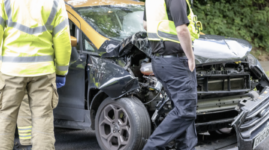The Criminal Offence of Vehicular Manslaughter Across Australia

Driving on our roads carries a number of risks and responsibilities, and failing to comply with the road rules can land a driver on the wrong side of the law – potentially amounting to a traffic offence.
And while a careless mistake or momentary inattention can indeed to lead to an accident, such unintentional conduct can also amount to what has been described as vehicular manslaughter in the event it causes another person’s death.
Each Australian state and territory has enacted legislation which criminalises such conduct – primarily by way of offences such as manslaughter and dangerous driving occasioning death.
Here’s a rundown of those laws, including the penalties and legal defences that may apply.
What is vehicular manslaughter?
The crime of manslaughter involves the unlawful killing of another person which does not amount to murder.
There are two broad categories of manslaughter: involuntary manslaughter and voluntary manslaughter.
Involuntary manslaughter involves the unlawful killing of another person in the absence of the mens rea (or mental fault element) for the offence of murder.
Voluntary manslaughter occurs when all of the elements of murder are present (including the mental fault element) but the culpability of the offender’s conduct is reduced due to the circumstances of the crime.
Vehicular manslaughter is a form of involuntary manslaughter where a person drives a motor vehicle in a dangerous and criminally negligent way and causes the death of another person. In Australia, this crime is usually outlined as a discrete offence for dangerous / negligent / careless driving resulting in death.
The offence of dangerous driving occasioning death in New South Wales
In NSW, the offence of dangerous driving occasioning death is outlined under section 52A of the Crimes Act (NSW) which states:
A person is guilty of the offence of dangerous driving occasioning death if the vehicle driven by the person is involved in an impact occasioning the death of another person and the driver was, at the time of the impact, driving the vehicle–
(a) under the influence of intoxicating liquor or of a drug, or
(b) at a speed dangerous to another person or persons, or
(c) in a manner dangerous to another person or persons.
A person convicted of an offence under this subsection is liable to imprisonment for 10 years.
(2) A person is guilty of the offence of aggravated dangerous driving occasioning death if the person commits the offence of dangerous driving occasioning death in circumstances of aggravation. A person convicted of an offence under this subsection is liable to imprisonment for 14 years.
To establish the offence, the prosecution must prove beyond reasonable doubt that the defendant was:
- The driver of a motor vehicle
- Involved in an impact causing the death of another person, and
- Under the influence of alcohol or a drug, driving at a dangerous speed, or driving in a dangerous manner.
An ‘impact’ is defined as that which occurs:
- Between an object or a person and the vehicle,
- Between an object, including the ground, due to being thrown from the vehicle,
- With another vehicle or object in, on or near a person,
- With anything on or attached to the vehicle,
- With anything in motion through falling from the vehicle,
- When a vehicle overturns or leaves the road, or
- When a person falls or is thrown or ejected from the vehicle.
‘Circumstances of aggravation’ exist where the accused:
- Had a ‘prescribed concentration of alcohol’ in your bloodstream,
- Exceeded the speed limit by more than 45 km/h, or
- Was ‘very substantially impaired’ by a drug or drugs.
A ‘prescribed concentration of alcohol’ is a reading of at least 0.15.
As noted above, the maximum penalty for this offence is 10 years imprisonment for the general offence and 14 years for the aggravated offence.
The offence in Victoria
In Victoria, the offence of culpable driving causing death is outlined under section 318 of the Crimes Act 1958 (VIC) which states:
(1) Any person who by the culpable driving of a motor vehicle causes the death of another person shall be guilty of an indictable offence and shall be liable to level 3 imprisonment (20 years maximum) or a level 3 fine or both.
…
(2) For the purposes of subsection (1) a person drives a motor vehicle culpably if he drives the motor vehicle—
(a) recklessly, that is to say, if he consciously and unjustifiably disregards a substantial risk that the death of another person or the infliction of grievous bodily harm upon another person may result from his driving; or
(b) negligently, that is to say, if he fails unjustifiably and to a gross degree to observe the standard of care which a reasonable man would have observed in all the circumstances of the case; or
(c) whilst under the influence of alcohol to such an extent as to be incapable of having proper control of the motor vehicle; or
(d) whilst under the influence of a drug to such an extent as to be incapable of having proper control of the motor vehicle.
A further offence of dangerous driving causing death is outlined under section 319 of the Crimes Act 1958 (VIC) which states:
(1) A person who, by driving a motor vehicle at a speed or in a manner that is dangerous to the public having regard to all the circumstances of the case, causes the death of another person is guilty of an indictable offence and liable to level 5 imprisonment (10 years maximum).
The offence in Queensland
In Queensland, the offence of dangerous operation of a vehicle resulting in death is outlined under section 328A(4) of the Criminal Code (1899) which states:
…
(4) A person who operates, or in any way interferes with the operation of, a vehicle dangerously in any place and causes the death of or grievous bodily harm to another person commits a crime and is liable on conviction on indictment—(a) to imprisonment for 10 years, if neither paragraph (b) nor (c) applies; or
(b) to imprisonment for 14 years if, at the time of committing the offence, the offender is—(i) adversely affected by an intoxicating substance; or
(ii) excessively speeding; or
(iii) taking part in an unlawful race or unlawful speed trial; or(c) to imprisonment for 14 years, if the offender knows, or ought reasonably know, the other person has been killed or injured, and the offender leaves the scene of the incident, other than to obtain medical or other help for the other person, before a police officer arrives.
The offence in the Australian Capital Territory
In the ACT, the offence of culpable driving of a motor vehicle is outlined under section 29 of the Crimes Act 1900 (ACT) which states:
…
(2) A person who, by the culpable driving of a motor vehicle, causes the death of another person is guilty of an offence punishable, on conviction, by imprisonment for 14 years.(3) However, for an aggravated offence against subsection (2), the maximum penalty is imprisonment for 16 years.
…
(6) For this section, a person shall be taken to drive a motor vehicle culpably if the person drives the vehicle—
(a) negligently; or
(b) while under the influence of alcohol, or a drug, to such an extent as to be incapable of having proper control of the vehicle.
(7) For this section, a person shall be taken to drive a motor vehicle negligently if the person fails unjustifiably and to a gross degree to observe the standard of care that a reasonable person would have observed in all the circumstances of the case.
The offence in Tasmania
In Tasmania, the offence of murder causing death by dangerous driving is outlined under section 167A of the Criminal Code (Tas) which states:
Any person who causes the death of another person by the driving of a motor vehicle at a speed or in a manner which is dangerous to the public, having regard to all the circumstances of the case, including in the case of the driving of a motor vehicle on a public street, the nature, condition and use of the street, and the amount of traffic which is actually at the time, or which might reasonably be expected to be, on the street, is guilty of a crime.
The maximum penalty for this offence is life imprisonment.
The offence in the Northern Territory
In the Northern Territory, the offence of driving motor vehicle causing death or serious harm is outlined under section 174F of the Criminal Code (NT) which states:
(1) A person is guilty of an offence if:
(a) the person drives a motor vehicle dangerously; and
(b) that conduct causes the death of any person.
Maximum penalty: Imprisonment for 10 years.
(2) A person is guilty of an offence if:
(a) the person drives a motor vehicle dangerously; and
(b) that conduct causes serious harm to any person.
Maximum penalty: Imprisonment for 7 years.
(3) For subsections (1)(a) and (2)(a), a person drives a motor vehicle dangerously if the person drives the vehicle:
(a) while under the influence of alcohol or a drug to such an extent as to be incapable of having proper control of the vehicle; or
(b) at a speed that is dangerous to another person; or
(c) in a manner that is dangerous to another person.
The offence in South Australia
In South Australia, the offence of causing death or harm by use of vehicle or vessel is outlined under section 19A of the Criminal Law Consolidation Act 1935 (SA), which states:
(1) A person who—
(a) drives a vehicle or operates a vessel in a culpably negligent manner, recklessly, or at a speed or in a manner dangerous to any person; and
(b) by that culpable negligence, recklessness or other conduct, causes the death of another,
is guilty of an indictable offence.
Maximum penalty:
(a) where a motor vehicle or motor vessel was used in the commission of the offence—
(i) for a first offence that is a basic offence—imprisonment for 15 years and, in the case of an offence involving the use of a motor vehicle, disqualification from holding or obtaining a driver’s licence for 10 years or such longer period as the court orders;
(ii) for a first offence that is an aggravated offence or for any subsequent offence—imprisonment for life and, in the case of an offence involving the use of a motor vehicle, disqualification from holding or obtaining a driver’s licence for 10 years or such longer period as the court orders;
(b) where neither a motor vehicle nor motor vessel was used in the commission of the offence—imprisonment for 7 years.
The offence in Western Australia
In Western Australia, the offence of dangerous driving causing death or grievous bodily harm is outlined under section 59 of the Road Traffic Act 1974, which states:
(1) If a motor vehicle driven by a person (the driver ) is involved in an incident occasioning the death of, or grievous bodily harm to, another person and the driver was, at the time of the incident, driving the motor vehicle —
(a) while under the influence of alcohol to such an extent as to be incapable of having proper control of the vehicle; or(ba) while under the influence of drugs to such an extent as to be incapable of having proper control of the vehicle; or
(bb) while under the influence of alcohol and drugs to such an extent as to be incapable of having proper control of the vehicle; or
(b) in a manner (which expression includes speed) that is, having regard to all the circumstances of the case, dangerous to the public or to any person,
the driver commits a crime and is liable to the penalty in subsection (3).
(2) For the purposes of this section —
[(a) deleted]
(b) it is immaterial that the death or grievous bodily harm might have been avoided by proper precaution on the part of a person other than the person charged or might have been prevented by proper care or treatment; and
(c) when an incident occasions grievous bodily harm to a person and that person receives surgical or medical treatment, and death results either from the harm or the treatment, the incident is deemed to have occasioned the death of that person, although the immediate cause of death was the surgical or medical treatment if the treatment was reasonably proper in the circumstances and was applied in good faith.
(3) A person convicted on indictment of an offence against this section is liable —
(a) if the offence is against subsection (1)(a), (ba) or (bb), or the offence is against subsection (1)(b) and is committed in circumstances of aggravation, to a fine of any amount and to imprisonment for —
(i) 20 years, if the person has caused the death of another person; or
(ii) 14 years, if the person has caused grievous bodily harm to another person;
or
(b) in any other circumstances, to a fine of any amount and to imprisonment for —
(i) 10 years, if the person has caused the death of another person; or
(ii) 7 years, if the person has caused grievous bodily harm to another person,
and, in any event, the court convicting that person shall order that he be disqualified from holding or obtaining a driver’s licence for a period of not less than 2 years.
Key terms related to vehicular manslaughter in Australia
There are a number of key terms related to the offence of vehicular manslaughter that need to be understood in order to determine whether a charge will be proven beyond reasonable doubt.
Killing a person
A person will be ‘killed’ for the purposes of the criminal law if an actions leads to the irreversible cessation of circulation of blood in the body, or the irreversible cessation of all function of the brain. Notably, a foetus is generally not considered a ‘person’ for the purposes of the offence of murder.
Unlawfully killing
The offence of murder only applies to ‘unlawful’ killing. This means that if the law otherwise excuses the killing, say in the circumstances of fatal violence by military personal or law enforcement or as a result of a formal defence such as self-defence, a person is not able to be prosecuted for murder.
Causing death
An act or omission is considered to have ‘caused the death’ of another if it was a ‘substantial or significant caused’ of the death, even if some other cause was also operating at the time.
An act or omission will have caused death unless there is a break in the chain of causation, which will only occur if the original injury is merely the setting in which the subsequent cause operates, or if the subsequent cause is so overwhelming that it significantly diminishes the relevance of the original cause.
Examples of where the chain of causation is not broken include:
- Where the victim refuses medical treatment on religious grounds,
- Where subsequent medical treatment is poor, unless the injury had almost healed, and
- Where the victim engaged in unconscious acts that led to death.
The prosecution must prove causation, and a defendant is entitled to an acquittal if the prosecution fails to do so.
For example, a defendant was found not guilty in a case where the prosecution was unable to disprove that an underlying disease was the cause of the complainant’s death.
Defences to vehicular manslaughter in Australia
The offence will not be committed if a person did not unlawfully kill another or did not drive carelessly, negligently or dangerously.
In circumstances where the prosecution is able to prove all of the essential elements of the offence beyond all reasonable doubt, a number of legal defences apply to the charge, the most common of which is self-defence.. And it is important to be aware that if evidence raises the availability of self-defence, the prosecution must then disprove the defence beyond a reasonable doubt.
If the prosecution is unable to do this, the defendant must be found not guilty.
The defendant may also be found not guilty on the basis of mental health impairment or cognitive impairment (the ‘insanity defence‘).
Have you been charged with a driving offence?
The profession-leading criminal defence team at Sydney Criminal Lawyers has been successfully defending allegations of vehicular manslaughter for more than two-decades,.
So if you or a loved-one is suspected or has been charged with such an offence, call us anytime on (02) 9261 8881 to get Australia’s most awarded and successful criminal defence firm on your side.






